
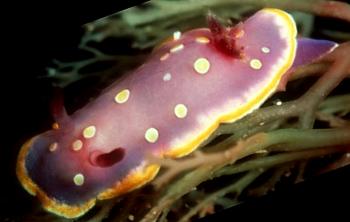
Chromodoris luteorosea
(von Rapp, 1827)
Order: NUDIBRANCHIA
Suborder: DORIDINA
Superfamily: EUDORIDOIDEA
Family: Chromodorididae
DISTRIBUTION
Western Mediterranean and nearby Atlantic coast of Spain and Portugal.
PHOTO
UPPER: Bay of Algeciras (Strait of Gibraltar, Southern Spain). Size: 25 mm., Depth: 26 m. Date: April 2000. PHOTO: Alma Sánchez
LOWER: Mediterranean Coast of Spain. PHOTO: Diego Moreno.
Grows to about 55 mm. General body colour is purple. The mantle is edged in yellow and the are yellow spots and the mantle and the foot, each spot edged in white. The rhinophores are dark reddish brown and the gills a similar translucent colour with some white markings.
See Angel Valdes' message comparing this species with Chromodoris luteopunctata.
Authorship detailsRudman, W.B., 2001 (January 23) Chromodoris luteorosea (von Rapp, 1827). [In] Sea Slug Forum. Australian Museum, Sydney. Available from http://www.seaslugforum.net/find/chrolute
Related messages
Re: Chromodoris luteopunctata? from NE Spain
July 3, 2008
From: Angel Valdes
Concerning message #21663:
Dear David and Bill,
Lucas Cervera and I have been emailing each other regarding this animal and we can't agree in a positive identification. He thinks this animal is C. luteorosea based on the distribution, shape and number of dorsal spots. I think it is C. luteopunctata based on the blue and white spots on the rhinophores. I am pretty sure the rhinophores of C. luteorosea are consistently purplish-brown with no spots or just a few lighter spots, but Lucas thinks there is some variation and he has seen animals with blue and white spots, he is going to check to make sure. We also discussed the possibility that this could be a hybrid between the two species, or that C. luteorosea and C. luteopunctata are just variations of the same species and this is an intermediate form. But of course, we can't prove either claim.
Sorry we can't help very much,
Angel
aavaldes@csupomona.edu
Valdes, A., 2008 (Jul 3) Re: Chromodoris luteopunctata? from NE Spain. [Message in] Sea Slug Forum. Australian Museum, Sydney. Available from http://www.seaslugforum.net/find/21671Dear Angel,
Thanks for the quick response. I am glad you are puzzled to. I read and re-read your earlier comments, and Lucas's, and was wondering if there was something obvious I had missed. Looks like these two species need to be added to someone's TO DO list
Best wishes,
Bill Rudman
Re: Chromodoris luteopunctata? from NE Spain
July 2, 2008
From: David Abecasis
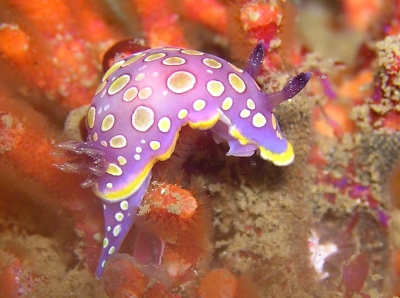
Concerning message #20910:
Hello Bill,
I have recently taken this picture of a Chromodoris but I have some doubts regarding the species. It seems to have spots on both rhinophores and gills so it could be a C. luteopunctata. But on the other hand the colors around the mantle line yellow border are more typical of C. luteorosea.
Locality: Armação de Pêra, 16 metres, Portugal, Atlantic Ocean, 26 June 2008, Rocky. Length: 1 cm. Photographer: David Abecasis.
Which species do you think it is?
Best regards,
David Abecasis
davidbecas@netcabo.pt

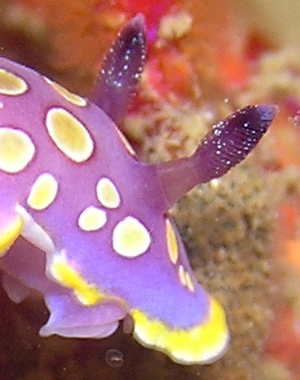
Dear David,
I can see your problem. This animal looks very much like some in a message from Senegal [message #10260] in which I said some characters, like the white spots on gills and rhinophores are characteristic of C. luteopunctata but the large regular spots are characteristic of C. luteorosea.
I am afraid I give up. Hopefully Angel Valdes or Lucas Cervera can give us the benefit of their experience.
Best wishes,
Bill Rudman
Chromodoris luteopunctata? from NE Spain
October 11, 2007
From: Jordi Regàs


Dear Dr.Rudman,
Here are three pictures of what I think could be a Chromodoris luteopunctata. According to other messages on the Forum, in this case the white spots on the rhinophores could confirm the species (indeed there's some discussion about this detail, as reported also in the Forum).
Locality: Canons de Tamariu, Tamariu, 33 meters, Girona, Spain, Mediterranean Sea, 21 July 2007. Length: 15-20 mm. Photographer: Jordi Regàs.
My main reason for sending the photos was to increase the collection of photos of animals looking like Chromodoris luteopunctata and/or C. luteorosea.
Best regards,
Jordi Regàs
jordiregas@gmail.com
Regàs, J., 2007 (Oct 11) Chromodoris luteopunctata? from NE Spain. [Message in] Sea Slug Forum. Australian Museum, Sydney. Available from http://www.seaslugforum.net/find/20910
Dear Jordi,
Thanks for the extra photos, it is certainly the best way to sort out the limits to colour variation in this group. I suspect however that these, like those in your other message [#20909 ],are C. luteorosea rather then C. luteopunctata. Although there are some white spots on the gills I can't see any sign of them on the rhinophores. It will be interesting to hear the views of local experts. One colour chracter which seems to distinguish this species from C. luteopunctata is that there is a white line or zone between the outer yellow mantle margin and the blue and purple of the rest of the mantle. This does not occur in C. luteopunctata. Instead there is a thin, dark reddish band.
As far as I can see C. luteopunctata is an Atlantic species which has only been recorded extending into the Mediterranean as far as the Straits of Gibraltar. If that is its real limit, then your animals from near the border of mediterranean France and Spain are more likely to be C. luteorosea.
Best wishes,
Bill Rudman
Chromodoris luteorosea from Pantelleria Is., Italy
October 11, 2007
From: Jordi Regàs


Dear Mr. Rudman
Here some pictures about what I think it's Chromodoris luteorosea.
There are two different slugs in the photos. The animal in the upper photo was taken on 06 September 2007, and the other two are pictures taken of another animal, pictured 3 days later, at the same spot.
Locality: Il Faraglione, Cala Levante, 28 meters, Pantelleria Island, Italy, Mediterranean Sea, 06 September 2007. Length: 15-20 mm. Photographer: Jordi Regàs.
Jordi Regàs
jordiregas@gmail.com
Regàs, J., 2007 (Oct 11) Chromodoris luteorosea from Pantelleria Is., Italy. [Message in] Sea Slug Forum. Australian Museum, Sydney. Available from http://www.seaslugforum.net/find/20909
Dear Jordi,
Thanks for these photos. Yes this is C. luteorosea. One colour chracter which seems to distinguish this species from C. luteopunctata is that there is a white line or zone between the outer yellow mantle margin and the blue and purple of the rest of the mantle which is absent in C. luteopunctata.
Best wishes,
Bill Rudman
Re: Chromodoris luteorosea from below
October 16, 2003
From: Adam Petrusek

Hi Bill,
As you thought, there were no white spots on the rhinophores. Here is another photo of the same specimen to prove it.
Photo: Jan Prochazka
Adam
petrusek@cesnet.cz
Petrusek, A., 2003 (Oct 16) Re: Chromodoris luteorosea from below. [Message in] Sea Slug Forum. Australian Museum, Sydney. Available from http://www.seaslugforum.net/find/11242Thanks Adam
Bill Rudman
Re: Chromodoris luteorosea from below
October 13, 2003
From: Adam Petrusek

In answer to your request here is a photo of the same animal, this time the dorsal side and underwater.
Photo: Adam Petrusek
Adam
petrusek@cesnet.cz
Petrusek, A., 2003 (Oct 13) Re: Chromodoris luteorosea from below. [Message in] Sea Slug Forum. Australian Museum, Sydney. Available from http://www.seaslugforum.net/find/11219Thanks Adam,
It certainly looks like Chromodoris luteorosea. I was curious to see if your animal had white spots on the rhinophores. I suspect the one white spot visible is a small white particle - shell grit or something similar
Best wishes
Bill Rudman
Chromodoris luteorosea from below
October 12, 2003
From: Adam Petrusek

For those who are used to seeing sea slugs only from above I include an interesting photo of Chromodoris luteorosea from below. You can see nicely the foot, the mantle and probably some food (?) in the slug...
Locality: Adriatic sea, near Sumartin, island Brac, Croatia.
Date: September 7, 2003
Photographed in the aquarium during the Mediterranean Marine Fauna excursion of the Charles University, Prague. Photo: Martin Cerny.
All the best
Adam
petrusek@cesnet.cz

Thanks Adam,
It's good to get some unorthodox views of these animals to show anatomical features not usually seen. I've included a slightly manipulated image alongside to show the oral tentacles. The mouth, although not visible, is on the 'snout' that bears these tentacles. See also the dorid head Page.
The blackish lump in your full photo is not food in the stomach but the digestive gland, sometimes called a 'liver'. It is a uniquely molluscan organ and as its name suggests produces digestive enzymes which are used in the stomach to digest the food. The broken down food is then transported into the digestive gland where specialised cells absorb the food partcles and excrete leftover waste which moves down into the intestine and out of the body.
Although we have a few photos of this species in the Forum, if you have any dorsal photos of this species from Croatia, they would be an interesting addition. As you can see there appears to be some variation in colour pattern in this species.
Best wishes
Bill Rudman
Chromodoris luteorosea from Tunisia
August 21, 2003
From: N. & B. Mansuy

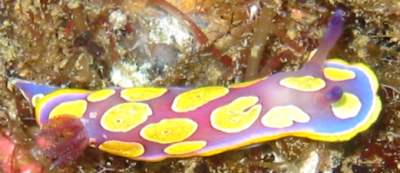
Dear Bill,
First, congratulations on your website. Here are some photos of a seaslug found in Mediterranean Sea, near the city of Port El Kantaoui (Tunisia) on August 2003
We have seen it at 16m depth and size approximately 40mm.
Do you think it is Chromodoris luteorosea?
Nathalie & Benoit Mansuy
maya.ch193@gadz.org
Mansuy, N.& B., 2003 (Aug 21) Chromodoris luteorosea from Tunisia. [Message in] Sea Slug Forum. Australian Museum, Sydney. Available from http://www.seaslugforum.net/find/10792Dear Nathalie & Benoit,
This is indeed Chromodoris luteorosea. You can also see traces of white specks on the gills of the upper photo. As I discuss in Marina's earlier message, white specks seem to be quite common in this species, suggesting that these specks are not a good way of distinguishing this species from Chromodoris luteopunctata.
Best wishes,
Bill Rudman
Re: Chromodoris luteorosea? from Senegal
August 9, 2003
From: Marina Poddubetskaia


Dear Bill,
I'd like to come back to your thoughts concerning the presence or not of white spots on the gills and rhinophores in C. luteorosea. The upper photo is of a specimen from the Mediterranean. According to its very large spots I think there is no doubt that it is C. luteorosea. Somehow, it does not have white spots on the rhinophores. Moreover, a year ago I sent you a photo of this species [lower photo and see earlier message] in which these white spots on the gills and rhinophores can be seen well. So, I don't think that this characteristic should be considered as distinguishable in this species.
Upper Photo:
Date: July 11, 2003
Location: Cerbere, France, Mediterranean coast
Site: Les Chambres
Depth: 12m
Size: 20-25mm
Lower Photo: see earlier message.
Photos: Marina Poddubetskaia - Nembro website
Cheers,
Marina.
nembro@nembro.info
Poddubetskaia, M., 2003 (Aug 9) Re: Chromodoris luteorosea? from Senegal. [Message in] Sea Slug Forum. Australian Museum, Sydney. Available from http://www.seaslugforum.net/find/10641
Thanks Marina,
As I said in my earlier message, the differences between C. luteorosea and Chromodoris luteopunctata seem to be part of a continuum. The differences I mentioned, such as white spots on gills and rhinophores had been suggested by local experts. Your animal from Senegal clearly had features of both 'species', as does your lower photo in this message. [I have added a close-up of the gills and rhinophores of your lower photo to show the white spots said to be 'typical' of C. luteopunctata].
One problem with sorting out the Mediterranean 'blue chromodorids' has I think been the lack of sufficient material. Until we have a more complete understanding of the total colour variation within a species then deciding just what characterises each species is impossible. While in some cases major anatomical differences can be found between two very similarly coloured species, in other cases there are few anatomical variations and they are difficult to characterise. So again I think we need to look at biological characters - such as what each species eat and what egg masses look like etc.
Best wishes,
Bill Rudman
Chromodoris luteorosea? from Senegal
June 23, 2003
From: Marina Poddubetskaia

Dear Bill,
Here is another find from Dakar. I think it is Chromodoris luteorosea, isn't it?
Date: June 01, 2003
Location: Dakar, Senegal, Eastern Atlantic
Site: Le Grand Thiouriba
Depth: 37m
Size: 15mm
Photos: Marina Poddubetskaia - Nembro website
Best wishes,
Marina.
nembro@nembro.info
Poddubetskaia, M., 2003 (Jun 23) Chromodoris luteorosea? from Senegal. [Message in] Sea Slug Forum. Australian Museum, Sydney. Available from http://www.seaslugforum.net/find/10260Dear Marina,
Thanks for another interesting find. I think it raises the question of whether C. luteorosea and C. luteopunctata are really different species. Your animal certainly looks like the animal Edmunds (1981) reported from Ghana as C. luteorosea but in recent messages to the Forum discussing these two species, Lucas Cervera and Angel Valdes list a number of exernal features to separate the two. The most obvious are the presence of white spots on the gills and rhinophores in C. luteopunctata and their absence in C. luteorosea. Both your animal and Edmund's Ghanaian animal have these white spots, considered typical of C. luteopunctata. However the arrangement of white-ringed yellow spots is typical of C. luteorosea, - in C. luteopunctata there are usually many small white spots in the central part of the mantle. Another difference is that C. luteorosea is said to have fewer gills arranged in a circle, while C. luteopunctata has more gills arranged in an arc with secondary spirals. On looking at other photos we now have on the Forum it seems the situation is not as simple as first proposed. Perhaps these differences are size related? and perhaps we are dealing with only one species. On the basis of the white spotted gills and rhinophores, and large number of gills, your animal would be C. luteopunctata, but on the general size and arrangement of the yellow spots and mantle glands it would be C. luteorosea.
Any thoughts would be welcome
Best wishes
Bill Rudman
Chromodoris luteorosea from France
July 25, 2002
From: Marina Poddubetskaia

Dear Bill,
Here are some photos of Chromodoris luteorosea and its juvenile, from Cerbere, on the Mediterranean coast of France.
Upper right, lower left: July 04, 2002, Site: L'Ocell, Depth: 18m, Size: about 2cm.
Lower right: juvenile, July 01, 2002, Site: Les 3 moines, Depth: 17m, Size: 8-9mm
Best wishes,
Marina.
Photos: Marina Poddubetskaia - Nembro website
nembro@nembro.info


Thanks Marina,
Bill Rudman
Chromodoris luteorosea & C. luteopunctata
February 5, 2001
From: J. Lucas Cervera
Dear Bill,
I was the first to collect C. luteopunctata after its original description by Gantes (1962) from specimens from Temara (Morocco). All my specimens were collected intertidally and the external appearance fits exactly the Gantes' description. In comparing the depth range of both species, I consider that Ch. luteorosea is more common in deeper water, while Ch. luteopunctata is found in shallower waters.
Ortea and Valdes (1992) described a "new" species, Ch. rodomaculata, based on 1 specimen from Canary Islands. However, I'm in agreement with Angel's recent message where he suggests that C. rodomaculata is a junior synonym of C. luteopunctata. Nevertheless, in their paper there is a good comparison between Ch. luteorosea and Ch. luteopunctata (unfortunately in Spanish). Ch. luteopunctata is distributed from the southern Iberian Peninsula, to Madeira and Canary Archipelagos and Moroccan coasts. The problem is that in this area Ch. luteorosea is also found, but its distribution is wider (from northern Iberian peninsula to Eastern Mediterranean, and also to Ghana. Most of the differences between both species are external, but consistent. C. luteorosea has rhinophores and gills lacking a white (bluish-white) puntuation on their surface and there are usually fewer gills than in Ch. luteopunctata. This last species has a branchial tuft with convoluted extremes (similar to Glossodoris) and in C. luteopunctata the tuft is circular.
The edge of the mantle is yellow in Ch. luteorosea. Ch luteopunctata has a similar band, but also an inner blue-sky (sometimes whitish in some areas) band along all the mantle.
The yellow and circular patches of Ch. luteorosea are always bigger and lesser that in Ch. luteopunctata, and allways surrounded by a thin opaque white band. The yellow spots of Ch. luteopunctata can be almost white in the smaller ones or even mix both colors, but never presents the arrangement seen in Ch. luteorosea. The bigger spots in Ch. luteopunctata can appear eroded in its inner part.
if we look at the internal anatomy, probably the most important differences between both specis is the shape of the rachidian tooth: in Ch. luteorosea is much more wide than in Ch. luteopunctata. The other differences stated in Ortea and Valdes' (1992) paper should be taken with careful to distinguish both species (in my view).
There is not much biological information knoen about either species. I think that all this, basically, agrees with the information supplied by Angel in his previous message.
Cheers.
Lucas.
lucas.cervera@uca.es
Cervera, J.L., 2001 (Feb 5) Chromodoris luteorosea & C. luteopunctata. [Message in] Sea Slug Forum. Australian Museum, Sydney. Available from http://www.seaslugforum.net/find/3679Thanks Lucas,
Bill Rudman.
Re: Chromodoris luteorosea from Spain
January 28, 2001
From: Juan Lucas Cervera
Dear Bill:
The Alma's upper photo is Chromodoris luteorosea, but the lower one is Chromodoris luteopunctata (Gantès, 1962). For more information see:
J.L.CERVERA, J.C.GARCIA GOMEZ, J.A.ORTEA. 1989. On two rare chomodorid nudibranchs (Opisthobranchia: Chromodorididae) from the Eastern Atlantic, with the description of a new species of Glossodoris. Journal of Molluscan Studies, 55: 445-453.
Thanks.
Lucas.
lucas.cervera@uca.es
Cervera, J.L., 2001 (Jan 28) Re: Chromodoris luteorosea from Spain. [Message in] Sea Slug Forum. Australian Museum, Sydney. Available from http://www.seaslugforum.net/find/3651Thanks Lucas,
Bill Rudman
Re: Chromodoris luteorosea from Spain
January 28, 2001
From: Angel Valdes


Dear Bill,
The photos sent by Alma actually belong to two different species. The upper photo is in fact Chromodoris luteorosea (von Rapp, 1827), which has dendritic mantle glands, uniformly dark reddish brown rhinophores and dark reddish brown branchial leaves with some white pigment. The most characteristic feature of this species is the presence of perfectly oval or circular yellow spots on the dorsum, irregularly arranged. These spots are always surrounded by a white area. I enclosed another photo of this species [UPPER PHOTO] taken by Diego Moreno in the Mediterranean coast of Spain. Chromodoris luteorosea is common in the Mediterranean Sea and the Atlantic coast of Spain and Portugal.
Alma's lower photo represents a specimen of Chromodoris luteopunctata (Gantès, 1962), a very similar species originally described from
Morocco. This species is only found in the Gibraltar Straits area, North Africa and Canary Islands and it also has dendritic mantle glands. It is distinguishable from C. luteorosea in several regards.
The branchial leaves of C. luteopunctata are lighter and have numerous white spots. The rhinophores have a number of white and blue spots that are absent in C. luteorosea. The dorsal pattern of C. luteopunctata is formed by small, irregular yellow spots in the center of the dorsum, and larger spots on the mantle margin. These spots are also surrounded by a white area, but they are always irregular in shape. See the enclosed picture [LOWER PHOTO] of a specimen collected by Terry Gosliner in Trafalgar, southern Spain, for comparison.
There are several consistent anatomical differences between these two species and I think all opisthobranch specialists in the area agree in considering them as distinct. I would be curious to know if Lucas agrees with my identifications.
All the best,
Angel
avaldes@CalAcademy.org
Valdes, A., 2001 (Jan 28) Re: Chromodoris luteorosea from Spain. [Message in] Sea Slug Forum. Australian Museum, Sydney. Available from http://www.seaslugforum.net/find/3653Thanks Angel,
It would be interesting to know if there were any 'biological' differences between the two species. Perhaps they feed on different sponges, perhaps they have differently coloured or shaped egg masses or development type? Despite my exerience with very similarly coloured species in the Indo -West Pacific I am still very surprised that these are considered distinct species by specialists of that fauna.
Best wishes,
Bill Rudman
Chromodoris luteorosea from Spain
January 26, 2001
From: Alma Sánchez

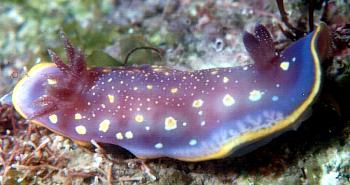
Dear Dr. Rudman,
Here are two photos from southern Spain. The upper photo is of Chromodoris luteorosea (von Rapp, 1827) which is easily distinguishable by the presence of rounded and yellow dorsal spots surrounded by thin white rings, whereas in the second photo (ass3) this chromodorid? has a much more irregular pattern: the yellow spots on dorsal surface are different in size and form. Can you help me?.
Data: Bay of Algeciras (Strait of Gibraltar, Southern Spain).
UPPER PHOTO: Size: 25 mm., Depth: 26 m.
Date: April 2000.
LOWER PHOTO: Size: 30 mm., Depth: 22 m.
Date: July 2000.
Best wishes,
Alma Sánchez
Dear Alma,
I am not familiar with these Mediterranean chromodorids but the pattern is so similar that I am sure they are the same species. Apart from the colour pattern, both animals show an identical pattern of dendritic white mantle glands on each side of the body, starting from just in front of the rhinophores. If I am wrong I am sure someone will let us know.
Best wishes,
Bill Rudman
